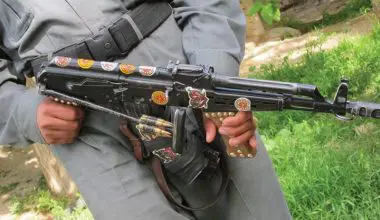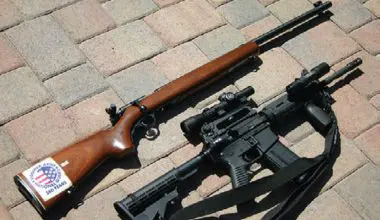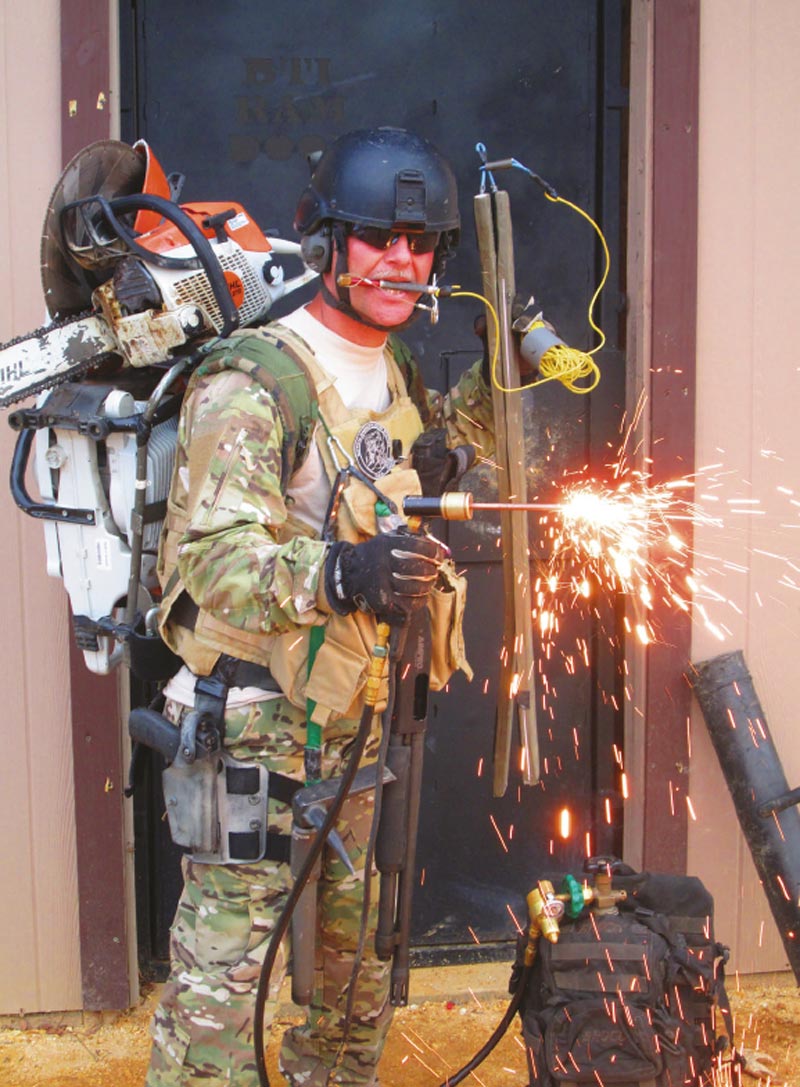
The Tactical Explosive Entry School was founded in 1991. In 2005 it was bought by Olive Group and expanded into a multi-function facility. However, most of the training staff vacated that venue in 2008 and regrouped under the new TEES moniker—Tactical Energetic Entry Systems. Since then, they have trained over 550 military units and police agencies.
Until the fall of 2012, TEES conducted courses at satellite facilities in Texas and Illinois and at host venues. Immediately following the International Breaching Symposium in June, TEES founder and President Alan Brosnan and Training Director John Mayer began construction on what Mayer described as a “dream range.” As a former Special Forces engineer and instructor, John brought a significant amount of experience and insight to the project. The facility, located in Mississippi, would need to support a full spectrum of breaching options, including hand tools, saws, torches and explosives, all of which are part of the firm’s training curriculum.
Table of Contents
BREACH HOUSE
The breach house itself needed to be flexible to prevent what John terms “shoot-house-itis,” a condition where after a few runs, students begin learning the floor plan, which is a major detractor from realistic training. This new 60 x 42 foot structure features 20 external breach points. A Breaching Technology Inc (BTI) pry door and ram door are affixed at each gable end, along with two windows. Five additional doors are along each of the house’s long sides to accommodate real doors. Two roof breaching openings round out the entry points.
When not in use, each opening has a flap to keep it out of play. With this configuration, a class can run for several days without students seeing the exact same floor plan pattern repeated.
The concept of door flaps continues on the inside. Two-thirds of the 13 rooms enter into a wide center hallway. Most rooms have two or more interconnecting doorways. Each doorway has a plywood flap that when closed looks like the adjacent wall.
This is far superior to simply using barricade tape to designate a doorway as off limits or out of play. Under stress, students may not immediately recognize the tape or react accordingly. The staff related that during an explosive breaching class, a student went to the wrong door and began placing a charge under the barricade tape before being stopped by an instructor. The flap not only ensures realism, but adds an additional layer of safety.
This is almost certainly the only training facility (with the exception of military venues) in the U.S. with a breaching house designed and built exclusively for this end-user purpose. There are a significant number of commercially built shoot houses up into the six-figure range that have limited, if any, breachable entry points. It’s rare to have any interior doors set up for forced entry.
According to Alan Brosnan, the new range will focus primarily on breaching. He has seen a change in the team’s training focus over the last decade. “The days of large teams coming back to train on tactics year after year are gone,” said Brosnan. “The money is not there anymore. But they do recognize the need for specialized breacher training.”

TEACHING BREACHING
Part of that recognition comes from TEES having a core cadre that all but exclusively teaches breaching as a fulltime profession. Another major component is having an array of apparatus on hand for students to use regardless of their experience level or team inventory. When students arrive for a course, everything they need for breaching (except their personal kit) is supplied as part of the course.
Along with this, TEES serves as a test bed where manufacturers send new devices for evaluation. The staff believes in teaching methods and apparatus that have a proven track record in actual operations, but also exploring innovations in the field.
Part of TEES accomplishment stems from networking with a large range of operational personnel from law enforcement and the military special operations community.
The new facility features a comfortable classroom that seats up to 40 students. Along the walls is an impressive display of unit and agency patches from TEES student base. There is a small kitchenette attached, and both bathrooms feature showers for students who need to catch a flight immediately after graduation. Adjacent to the classroom is a large team/assembly room containing all the tools needed for a course, along with the accessories.

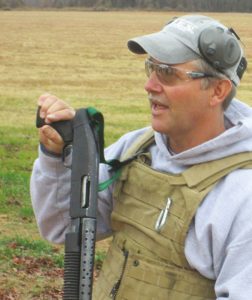
TEAM ROOM
TEES is a proponent of every operator in the stack carrying some type of breaching tool. If the team encounters a fortified room or locked door inside the stronghold, the tools are on the team members, where they are needed. This saves the time it would take a breacher to run back to the entry point. With this in mind, TEES maintains an array of collapsible tools from a variety of manufacturers.
But that is only part of the equation. Not only must students know how to use a device, they also must learn how to efficiently carry it. Students affix a section of PVC pipe to the MOLLE point on their vest as a tool carrier. A length of paracord serves as a pull strap. Breaching shotguns are attached to the vest with webbing and held in place with a belt retainer.
The team room is in close proximity to the breach house and training façades. Minimal downtime between training cycles is complemented by a well-designed layout of the components. Allowing trainees to quickly refit between runs maximizes the amount of repetitions per day.

MATERIAL CONSUMPTION
Attached to the team room is a workshop that directly supports the facility. Breaching is a labor and material intensive subject to teach. The nature of forced entries means doors and barricades are destroyed. Something needs to be replaced on every run in the breach house. Hence, pre-fabricated training aids and design features expedite reset time between exercises.
During a typical explosive handler and breaching course, 30 to 40 wood doors, 20 to 25 metal doors, drywall partition inserts, concrete block walls, and a mixed bag of lumber, screws and hardware are used. Add to this a range of explosives, from detonation cord to sheet explosive to detonating systems— all of which are provided as part of the class—and it’s easy to see that logistics become a full-time operation.
In addition to the support mission, the TEES staff uses the shop area to have instructor candidates build breaching façades and instructional aids as part of the Mechanical and Ballistic Breaching Instructor course.
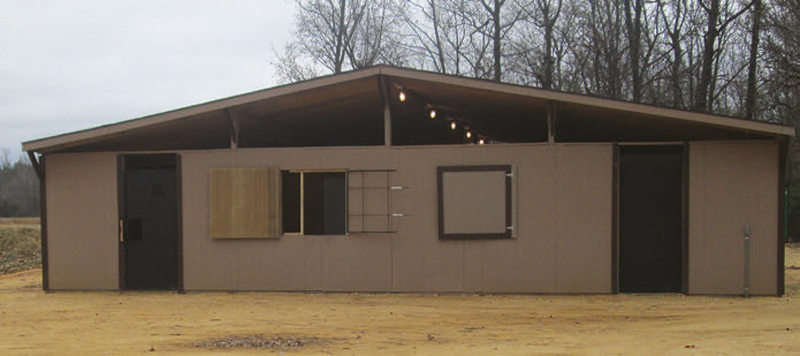
TRAINING GOALS
One instructional objective is equipping candidates with the skills to conduct a wide-ranging breaching program at their home agency. Although blueprints are included in the handouts, actually building a shotgun breaching stand with supervision (for example) will make the process easier at their own range.
A main goal of the facility is realistic training with quick reset. While instructors debrief students after an exercise, other staff members replace apparatus and reconfigure the layout plan. Each scenario is drawn out on a floor plan template to ensure the maximum amount of student involvement throughout.
What the cadre wants to avoid is a trainee hitting one door and then standing down for the remainder of the scenario. Even when a trainee is not directly involved in a breach, he is pulling security, providing cover or performing some other related task.
A mixture of breaching options during scenarios leads to a wider range of tools being used and keeps everyone engaged. This forces the students to slow down and examine the door to select the appropriate method of entry. According to Mayer, moving too fast allows students to get “amped up” and “outrun their headlights,” which can lead to mistakes or injuries. Communication among all participants is stressed, with instructors filling in dialogue as needed.
The interior door array in the breach house sustains the concept of progressive breaching. Some doors are set up with live lock sets that encourage trainees to try the doorknob before utilizing a tool. A majority of doors are set up for ballistic breaching or Internal Door Charge. There are several pull doors for pry tools and cage doors with chains, which require bolt cutters or saws.
Port charges are taught as part of the explosive breaching curriculum. Porting is fast becoming an added tactic for breachers. It can be an entry point or a smaller viewing port that allows operators to have “eyes on” the interior while a more deliberate breach is made on a fortified primary entry point.
A final attribute of the breach house is the replaceable drywall panels for porting or wall breaching. Chainsaws mounted on rucksack frames have proven very effective for this technique.


OTHER FEATURES
For live-fire training, there are rifle-caliber rated bullet traps inside the breach house. Nearby is a 12-point square range for CQB weapons training. While not a part of every course, live-fire training is an option.
Elsewhere on the facility are a variety of training façades for shotgun breaching, fence cutting, explosive charge placement drills, etc. This even includes a replaceable 10’ x 10’ section of concrete block and brick for explosive wall breaching. Students must become comfortable with the mechanical manipulation of a tool before they are put into a tactical environment in the breach house.
A series of obstacles completes the facility. First is a climbing fence for individual and team movements. As stated earlier, objectives include learning to carry and deploy the tools. A climbing exercise ensures students’ personal kit stays intact and team tools are utilized. Using tools to aid the climber is a tertiary lesson.
Chain-link fences are a common obstacle. There is a separate training aid on site that replicates a corner section with contiguous side panels. TEES teaches two methods for overcoming this barrier. First is simply using pole sections at the fence corner to create a makeshift ladder. The other uses a mechanical come-along ratchet to peel the bottom of the fence out of the way.
COMING ATTRACTIONS
Putting together this complex a facility and adjusting the training regimen in roughly six months are remarkable accomplishments, but the TEES staff is not content to stop there.
Future plans include modifying the breach house to accommodate additional roof breaching points and adding more exterior obstacles. A two-story Conex building to facilitate fast roping and high window breaching is also slated for the near future.
All in all, the new TEES facility was designed from the ground up for a focused purpose—providing basic to advanced breacher training with the most realism possible.
TEES has met their goal.



